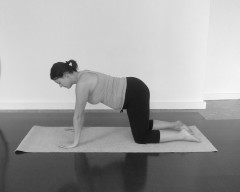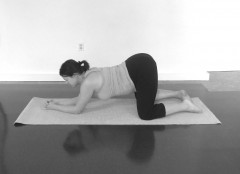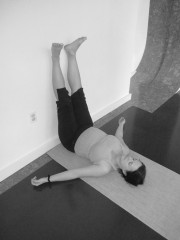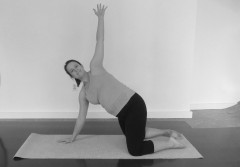The wrist is a fragile joint for anyone, but it comes under particular stress in the childbearing year.
A lot of people tend to call any wrist sensitivity “Carpal Tunnel”, but that’s not always accurate. There are over 20 kinds of soft tissue overuse injuries that can affect the shoulders down to the fingers, many of which are felt in the wrist. Carpal Tunnel Syndrome refers to the specific instance when the median nerve is pinched as it runs through the wrist (ie carpal) tunnel. Someone can have wrist pain but not have a pinched median nerve. In pregnant women, the ‘bracelet’ of the wrist bones feels especially sensitive because: the joint becomes unstable due to relaxin hormone; the increased blood flow from pregnancy is difficult to pass through a narrow joint; fluids pool in extremities, which causes swelling, causes even more narrowing of the passage. Wrist sensitivity in pregnancy tends to resolve itself when you take these issues away. In general, the main “cure” for it is finishing up pregnancy! However, there are many things you can do to lessen the discomfort.
In my prenatal practice, we spend a lot of time on all fours, bearing weight on the hands with the wrists flexed. In every class, I offer ways to modify the practice so that a woman doesn’t have to spend any time weight bearing on a sensitive wrist. Options include: making fists and putting knuckles down on the floor with straight wrists; splaying the fingers out like tent poles to bear weight ; or coming down on the forearms. Most women with sensitive wrists will cycle through all of those options in a class. It’s so important to keep practicing yoga, because even though you may have to modify in the above ways, the benefits of yoga outweigh that inconvenience.
As I mentioned above, swelling is one of the causes of wrist pain. Minimizing swelling everywhere in the body will help the wrists. Putting your legs up will help your wrists, as will any mild inversion (we do several in prenatal yoga). Drinking lots of water and eating water-rich foods (fruits and veggies), which helps reduce swelling, will also help the wrists.
Finally, keeping your circulatory system going will help improve the wrists’ sensitivity. Yoga is one of the best ways to improve your circulation. The asanas we practice in prenatal yoga stretch tight chests and shoulders. As our breasts change size in pregnancy, we tend to hunch and compress our thoracic outlet. Often, general discomfort in the forearms or wrists is greatly improved once we work out some of the knots in the shoulders and chest, because restriction of blood flow was starting all the way up there. Getting blood and prana (life force) to flow through the whole body, but especially the upper body, is the best healer for injury.
And don’t forget about the postpartum period! Though the causes of the wrist sensitivity in pregnancy might subside, now we have a whole new set of circumstances that can cause wrist pain. Women are operating on less sleep, are feeding babies in hunched positions for long periods of time, and are picking up babies often with really bent wrists (think baby sleeping in a bassinet next to mom and reaching over to pick up baby by contorting wrists). All these things put the wrists at continued risk for injury.
There are several non-yoga treatments possible to help sore wrists. Wearing a splint at night for sleeping or during the day when you’re resting (not when working) will keep your wrist in a neutral position. Acupuncture and massage are great. Vitamin B6 might be good for keeping the nerves healthy. Ask your practitioner about what they recommend!




Ah-ha! So that’s why my wrist has been bothering me! Thanks for the post!!
I had this problem during and after my pregnancy! You were so helpful in offering different positions and Jen Evans Acupuncture in Cambridge MA saved me (combined with lots of yoga) both during and post partum. Thank you for this useful post!
You really make it seem so easy with your presentation but I find this topic to be really something which I think I would never understand. It seems too complex and extremely broad for me. I’m looking forward for your next post, I will try to get the hang of it!